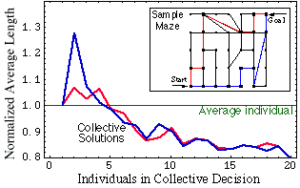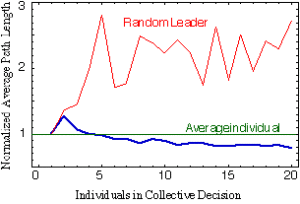The Symbiotic Intelligence Project
Self-Organizing Knowledge on Distributed Networks Driven by Human Interaction, from New Frontiers in Collective Problem Solving, by N. Johnson, S. Rasmussen, et al.; LA UR-98-1150 (1998).
The goal is to analyze and facilitate how people, in the process of accessing and using information on networks, create new knowledge without premeditation. We argue that the symbiotic combination of humans and smart networks will result in a previously unrealized capability of collective problem identification and solution. This capability is based on the pre-existing self-organizing dynamics of social evolution. This symbiotic intelligence will greatly increase the success of organizations in achieving their goals, better utilizing their resources and preparing for the future. For the human society as a whole, this new resource will improve our quality of life and vitality as a species.
The Project Motivation
We envision an unprecedented capability in organizational and societal problem solving will result from increased human activity on smart distributed information systems, like the Internet. This heightened capability will be an enhancement of the self-organizing social dynamics that has guided human groups, organizations, and societies for millennia. While sufficient connectivity is developing on the Internet (and intranets) to activate this transformation, the enabling methodologies and theories, along with the data needed to test the new technologies, are lacking. A multi-disciplinary, multi-institutional effort, The Symbiotic Intelligence Project, is being developed at Los Alamos with other institutions to provide the needed methodologies and theory for this new science. Los Alamos is ideally positioned to coordinate and contribute to this effort as the key laboratory in the study of complexity, artificial life, distributed processing and precompetative technology transfer.
The Role of Social Evolution
We have evolved social structures, and the supporting dynamics, which enabled us to “solve” problems that threaten our existence. With social evolution we can evolve and adjust to major changes in our environment within our own lifetime. Social and biological evolution use the same dynamic processes, and exhibit the same characteristics, inherent to self-organizing systems:
- A “Solution” arises as a selection by the system dynamics from a diversity of potential solutions.
- Complex global behavior is driven by loosely connected relatively simple, local processors.
- The global characteristics of these systems are: functionality greater than the individual subsystems, robustness, persistent nonequilibrium, the capability to find solutions in the presence of conflicting needs, and scalability without loss of viability.
In social dynamics, the “local processor” is the centralized problem solving of individuals, teams, organizations, and governments. This centralized approach relies on the premiere problem solving ability of humans to understand complex systems and to be able to predict their outcome. As a species we have gone through many fundamental reorganizations without centralized coordination: from hunter-gatherer to agricultural to industrial societies.
The Role of Technology in Social Evolution
Technological advances have radically changed the time and size (length) scales of the social dynamics, the prime example being the increase in the maximum size of a social group. Through advances in communication, transportation and information storage, our largest social unit has grown from tribes, to cities, to city-states, to nations, to regional coalitions, to almost a global society. Not unexpectedly the next revolution will also occur because of a new technology, the Internet.
Unique Capabilities of the Internet
The Internet has three significant capabilities beyond prior human-technological systems:
- The Net integrates the breadth of knowledge processes: information storage, communication of information, traditional computing of huge amounts of data, and human processing of limited but complex information. Until recently these were physically separated processes that required human action to integrate.
- The Net captures the depth of knowledge processes. The detailed signatures of the use of information are captured by the Net. This information was previously obtainable only at extreme cost.
- The Net transmits knowledge processes accurately. Verbal human-to-human communication results in a rapid loss of information a bit removed from its creator. By contrast, information exchanged or related on the Net, whether in web pages or emails, suffers minimal loss of information during transmission or linking, in the same way that the contents of a book or journal are not altered when exchanged.
With the stronger presence of these three capabilities in human information processes, we propose that a knowledge “phase change” will occur: these processes, which were previously lost or diminished before, will contribute to an enhanced self-organizing social dynamics.
A Simple Example of Collective Problem Solving on the Net
Have you ever clicked the “Check out these related titles!” on Amazon.com? These lists are not constantly updated by staffs of librarians for 2 million books. Instead, these lists are created by listing books purchased by people that have also ordered the selected book. This is an ideal example of capturing information that was previously lost (“depth of knowledge processes” above) and of how patterns of individual behavior lead to useful collective knowledge. Other demonstrations have been done or are in progress that illustrate how humans on intelligent, distributed networks can achieve useful collective solutions or knowledge, but with minimal instruction and effort. (Show me an another example.)
Simulations of Collective Problem Solving
Simulations are being done in T-Division at LANL (for a detailed discussion see: Collective Problem Solving: Functionality beyond the Individual ) that support the fundamental assumption that more people can effectively interact under “Internet-like” conditions than in traditional ways. These also illustrate the desirable features of a large and diverse self-organizing system. We ask the question: “What is the effect of noise or information loss on a collective decision involving many individuals?”
- The insert in the figure shows the demonstration maze. The main figure shows the effect on the collective solutions as more individuals contribute to the collective solution, for two different sets of random numbers. The number of steps of the collective is normalized by the average number of steps of the individuals contributing to collective solution.
The idealized problem is a maze which represents a bounded system where individuals are faced with a sequence of decision points that lead to a final goal. In the above figure, a demonstration maze is shown with two of the possible 14 minimum paths of 9 steps highlighted. A simulation consists of two phases. In the Learning Phase the individuals explore the maze, with no global sense of the problem, until the goal is found. In the Application Phase they apply, but do not modify, what they have learned to “solve” the problem. Because the rules in the two phases involve random choices, a population of individuals result which represent a diversity of performance and preferred paths. For now, these individuals are taken to be independent, because we are interested in isolating the effect of collective decision making from the processes of shared learning. To find a collective solution, the individual contributions are then combined in various ways and then the same Application Phase is applied. This collective solution is then compared to the average performance of the individuals in the collective.
In the sample maze, the average number of steps of an individual to “solve” the maze is 34.3 in the Learning Phase and 12.8 in the Application Phase for 100 individuals. If a collective solution is calculated by just a simple average of the individual’s contribution, the performance is better than the average individual when more than five individuals are included. Also, one of the minimum paths is found for collectives with more than 20 individuals. This optimal solution (nine) is found even though the rules have no global sense of the problem and do not select for a minimum path. This minimum solution is, therefore, an emergent property of the system. The system also exhibits classical chaotic behavior in that a small change in the collective path preference can result in an entirely different, but still near optimal, path.
The collective solution is remarkably robust. Degradation of the individual’s contribution, however implemented, generally had no effect on just postponed the collective convergence to the minimal path. For example, by appropriate modification of the individual’s contribution to the collective, we find that the less dominant opinions of the individual have no effect on the performance of the overall collective decision (but does make the collective solution more noisy). Also the collective solution is insensitive to moderate amounts of random noise.
A few effects were found to degrade the collective solution. The worst degradation (figure above) was found to be the random selection of a “leader” during the solution, with a different individual selected at each node. It was also observed that the collective solution is degraded if only the “better” performing individuals contribute (those with shorter path lengths in the Application Phase) to the collective solution. This is a surprising result illustrating that even a diversity of performance is important to a collective solution. Using this idealized problem, it is can be shown that a diversity of learning experiences leads to a better performance in the collective decisions and that the collective is significantly more robust than the average individual in adapting to unexpected changes in the final goal or the structure of the maze.
These simulations also give important information on how to best capture the diversity of the population in the creation of a self-organizing system. It is found that the diversity of experience in the problem space is essential to the collective solution, but not the relative importance of this experience. In contrast, it was also found that the individual’s diversity for preference at a node is not important, but it is essential that the relative importance of the individual’s preferences be captured.
These simulations demonstrate that under the ideal conditions of the Net (no loss and breath and depth of diversity of an individual’s preferences), large numbers of individuals can contribute to a collective decision and the collective performs much better than the average individual. One could imagine duplicating the same “simulations” on the Net, but with real individuals solving the maze, instead of the Learning Rules. Because the individual performance would likely be greatly improved, one would expect the collective solutions to be able to solve more complex mazes with fewer numbers of individuals. With the addition of the concept of a hierarchical structure of systems, the simple idea presented in these simulations can be extended to more and more complex systems. Therefore, while the current simulations are admittedly simplified, they may capture the fundamental nature of systems for collective decision making.
The Future
The implications of the ideas under investigation reach far into the future success of organizations, society, and economics. With the increased use of the Net in our economy and society, many problems that have challenged traditional management and organizations may now find solutions. The importance of this alternative will become more significant as the complexity of our world increases and our traditional ways of solving problems fail. The main consequence will be for management and governments to facilitate the use of collective problem-solving when problems arise in systems that are not understandable. The capabilities of artificial intelligence (AI) is making the Symbiotic Intelligence Project gain new meaning.

